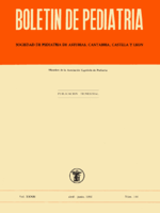Estudio de enteropatógenos en población infantil del área sanitaria del Hospital Universitario de Valladolid
J.I. Reguera , J.M. Eiros , C. Gobernado , P. Machín , M.R. Bachiller , R. Ortiz de Lejarazu , A. Rogdríguez Torres
Bol. Pediatr. 1992; 33 (144): 185 - 191
En este trabajo se presentan los resultados del estudio virológico y bacteriológico de 426 muestras de heces analizadas en el Laboratorio de Microbiología del Hospital Universitario de Valladolid, durante el período comprendido entre febrero y octubre de 1989. La prevalencia de rotavirus, adenovirus y bacterias enteropatógenas fue del 4,9 %, 0,2 % y 18,3 % respectivamente. De estas últimas Salmonella ententidis (7,3 %) y Campylobacter jejuni (7,3 %) han sido las más frecuentes. No se han encontrado variaciones estacionales para rotavirus ni para adenovirus. La prevalencia de bacterias enteropatógenas ha sido mayor en los meses secos y cálidos del año.
Study of enteropathogens in the infantile population of the sanitary area of the University Hospital of Valladolid
Virological and bacteriological results from 426 stool samples analyzed in the Microbiology Laboratory of the University Hospital (Valladolid) during the period February through October 1989, are presented. The prevalence of rotavirus, adenovirus and enteropathogen bacteria are 4.9 %, 0.2 % and 18.3 %. Salmonella ententidis (7,3 %) and Campylobacter jejuni (7,3 %) are the more frequent bacteria isolated. No seasonal variations were seen for rotavirus and adenovirus, but the prevalence of enteropathogenic bacteria was very marked in the hot dry months of the year.
Artículo completo (PDF) (446 kb.)
- Gastroenterología
